D15B 3 Stage VTEC
Before you can understand what is meant by "3 Stage VTEC", you have to be clear about what VTEC is. VTEC is simply a cam profile switching mechanism. Two cams are combined into one: a street friendly cam that idles well, makes good power in the low and mid RPM band, has low emissions; and another optimized purely for high RPM power. On the D-series engine this is applied to the intake valves only.
In 1992 Honda came up with a fuel-economy application for their cam switching strategy called VTEC-E. This time they used VTEC to switch between 12 valve and 16 valve operation. Closing one valve increases the speed of air flow into the engine at low RPM to keep the engine running smoothly and also creates a swirl effect in the combustion chamber that spreads the fuel evenly allowing for a very lean air-fuel ratio avoiding abnormal combustion.
By the time the sixth generation Honda Civic was released, Honda had decided that they could combine both VTEC-E and VTEC into one SOHC D-series engine. Stage one would be 12 valve operation of VTEC-E, Stage two being normal 16 valve operation, and Stage three being the VTEC performance cam profile. This resulted in excellent fuel economy from a high performance, small displacement SOHC engine. Unfortunately, market considerations as well as emissions regulations prevented this motor from reaching the United States.
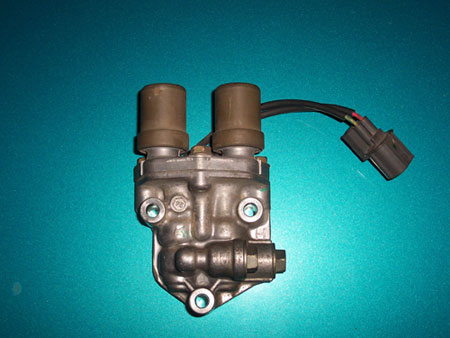
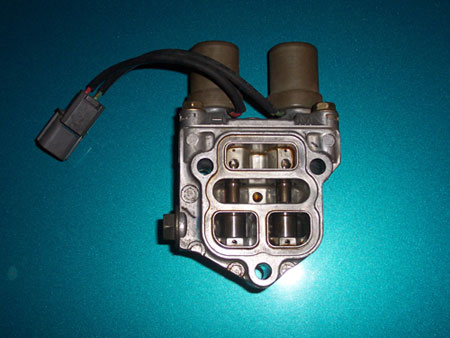
D15Z7
In Japan the engine block is stamped "D15B"; rather cryptically, considering that there are OBD0 non VTEC engines and OBD1-OBD2 SOHC VTEC engines also stamped "D15B". There are also the most commonly known USDM D15B# engines that came stock in all 92-95's except the Si/EX and Del Sol VTEC. When you go on an internet forum or call an engine importer asking about a D15B, people are going to assume that you're talking about one of these other motors because the "3 Stage VTEC" motor just isn't commonly known. People will swear to you that it doesn't exist.
Outside of Japan the engine block is stamped D15Z7. This is the most convenient way to refer to this engine, even though you may have the JDM version stamped "D15B". "3 Stage VTEC" is a very cumbersome term and causes all kinds of confusion, especially among people who have no interest in the D-series engines.
The "D15B" I am referring to comes from the OBD2 (1996-1999), EK3, Civic VTi / Civic Ferio Vi. With the exception of the dual VTEC solenoids, it's very similar to the D16Y5, or the D16Y8 but with EGR. This motor alters both the intake valve size (by keeping one valve mostly closed under certain conditions) and intake valve lift, duration, and timing.
The engine produces 128.2 hp @ 7000 RPM and 102.7 ft/lbs @ 5300 RPM. It has a redline of 7300 RPM. Compression ratio is 9.6:1. Recommended Octane is 91 RON or 87 CLC (USA). Engine size is 1493cc.
"3 Stage", or "Dual VTEC"?

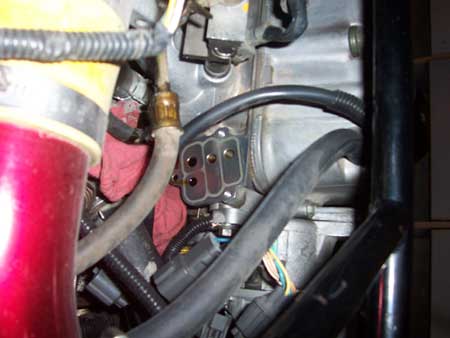
The motor has two VTEC solenoids giving you three stages of operation. As with the other Civic SOHC engines from this time period, VTEC and VTEC-E only act on the intake valves.
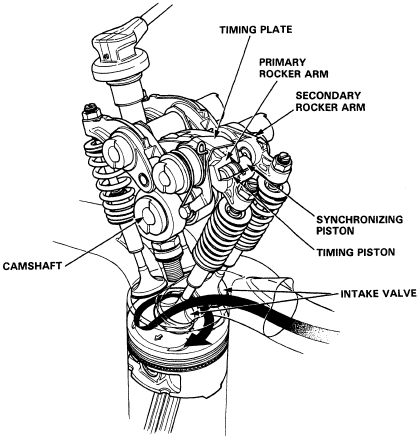
Stage 1: 12 Valve mode: The secondary cam lobe is practically round, opening the intake valve just enough to to let fuel through. At lower RPM's, the engine's air demands are small. By decreasing the size of the path that the air takes to get into the combustion chamber you increase its speed. This packs more air into the combustion chamber than a 16 valve design up until about 2500 - 4000 RPM (depending on throttle position). Also, since the air is entering the combustion chamber at the corner through only one intake valve, it swirls around the combustion chamber which helps vaporize the fuel and mix it evenly.
Stage 2: 16 Valve mode: the VTEC-E solenoid is powered up locking the intake valves to the primary cam lobe. The engine's demand for air is higher so a larger, less restrictive air passage is required to maximize volumetric efficiency.
Stage 3: VTEC: The intake valves that were previously locked to the primary lobe are now locked to the mid lobe which opens earlier, stays open longer, opens higher, and has more overlap with the exhaust valve. This increases air flow in the high load/RPMs broadening the power band even further.
Swap into 1992 Civic VX
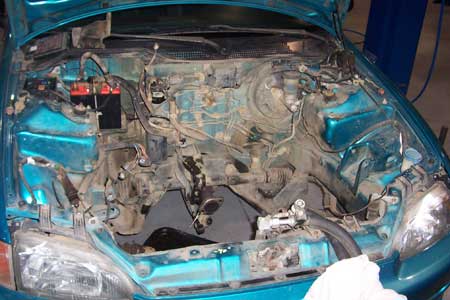
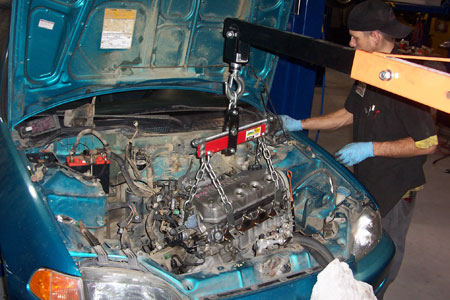
What To Keep (D15Z1)
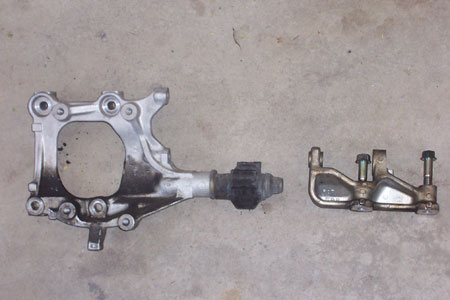
Here are some things to scavenge from your VX motor before you sell it on fuelly.com. Some of these should immediately be transferred onto your new motor, and some other things should be kept as spare parts.
- Lower Alternator Mount (lightweight aluminum)
- Front Lower Engine Mount (lightweight aluminum)
- Starter (re-usable)
- Alternator (re-usable)
- MAP Sensor (re-usable)
- IACV (re-usable)
What To Sell (D15Z1)
- Distributor (same as D16Z6)
- VTEC Solenoid (same as D16Z6)
- TPS Sensor (will fit almost any d, b, h, f engine)
- EGR Control Box found on the firewall
- Wideband O2 Sensor and wiring
What To Sell (D15B 3 Stage VTEC)
- Distributor (will fit any 96-00 D-series)
- Alternator
What Not to Keep j/k
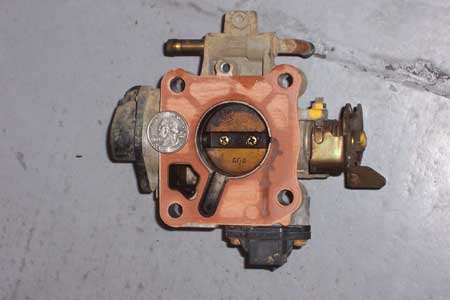
This picture of the VX throttle body gives you an idea of the awesome power potential of the D15Z1 *sarcasm.
OBD2 Engine, OBD1 Car
Injectors
OBD1 injector harness plugs are different than OBD2, so use some OBD1 injectors with OBD2 injector O-rings.
The CX/VX injectors are 190CC vs the DX/EX/Si/Integra's 240CC. In my case, I'm using 240CC injectors left over from my 1.6 liter ZC SOHC VTEC. I had them balanced and blueprinted by RC back in the day. Also, they'll tolerate a bigger increase from the stock hp w/out running out of fuel (after tuning I found that at max load these injectors are only at 45% duty cycle!). If you're using a stock ECU you'll have to use the injector size that came with the motor (I'm not sure if they're 190CC or 240CC).
Alternator
OBD2 engines have different alternator plugs than OBD1 engines. Just re-use your OBD1 alternator. Don't forget to swap over your VX lower alternator mount as it is considerably lighter than that of any other D-series.
Distributor
OBD2 Distributor plugs are different than OBD1 distributor plugs, so you have the option of re-pinning your OBD1 harness to the OBD2 plug, or using an OBD1 SOHC non-VTEC distributor (TD41U or TD31U). The VX distributor will work on OBD1 VTEC engines only (D16Z6, D15Z1, ZC SOHC VTEC). Luckily, I had an OBD1 DX distributor (TD41U). This distributor is identical to the OBD2 distributors except for the plug. I went ahead and swapped the ignitor and coil from the low mileage JDM distributor that came with my new engine.
Throttle Cable / Throttle Bracket

The OBD1 throttle cable doesn't match the OBD2 intake manifold / throttle body very well. In a pinch, you can put your old engine's throttle bracket in a vice and bend in backward. This leaves you with no real adjustment and an akward angle. A throttle cable bracket from an 85-87 CRX with the 12V fuel injected motor is a pretty close match or you could get a throttle cable from a 96-00 Civic HX/EX or SOHC Si.
Charcoal Canister
The OBD1 charcoal canisters have three hoses on top while the OBD2 canisters only have two. The OBD2 motors lack the vacuum hose on the throttle body for the third hose. So I got a 96-01 Acura Integra charcoal canister. It is similar to the 96-00 Civic canister except that it has a larger capacity. Either canister slides right into your firewall mount and fits the lower hose. The lines on top of the canisters are marked "tank" and "PCV" (in this case "PCV" stands for "purge control valve"). The "tank" hose goes to the fuel line on the firewall and the "pcv" hose goes to the purge control valve in the center of the intake manifold. I wired this valve to the wiring for the old purge control valve, but unfortunately the OBD1 ECU doesn't control it correctly and you will get a surging idle. The AEM EMS will have no trouble controlling it. If you're converting your car to OBD2 and using the rare P2J 3 Stage VTEC ECU, then you'll want to use the OBD2 Purge Control Valve.
IAT Sensor
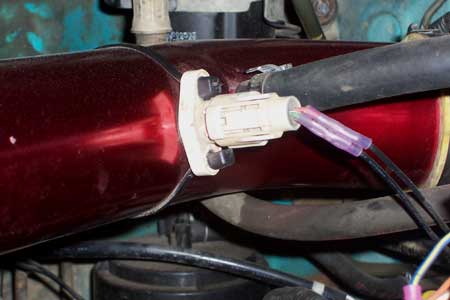
The OBD2 intake manifold doesn't have a provision for the IAT sensor like the OBD1 version. Instead, the IAT sensor is mounted to the intake pipe near the throttle body. Extend your sensor's wires and put your IAT in a hole in your intake pipe. Two long zip ties work great for holding it in place.
Vacuum / Coolant Hose
Make sure to have small diameter vacuum and coolant hose on hand.
Running an OBD1 ECU
It's best to get this engine up and running using your stock ECU before trying the AEM EMS. In my case, we ran into problems syncing the AEM to the distributor and so it became necessary for me to run the engine on the stock VX ECU for several months! I was surprised that it would run / idle at all, but in fact, in ran quite well w/out having either VTEC operational. I had to cut the O2 sensor's heater wire (D16 blue/green) to prevent the ECU from going into lean-burn mode because I was getting a lean misfire. This ECU was not meant for the trans I'm using. The ECU throws a CEL for EGR and O2 Sensor heater, but it runs fine albeit only getting 25 mpg. (Not to mention I was using 240CC injectors vs the VX's 190CC)
Now that the AEM EMS is up and running I'm averaging about 38 mpg. With further ignition tuning I'm confident that I could pick up another 5 mpg.
FF-Squad OBD1 ECU PinoutsRecommended Shops
- Motiva Performance Engineering
- 6919 Montgomery Blvd
- Albuquerque, NM 87109
- 505-883-8388
- http://www.motivaperformance.com/
I personally drove my car 815 miles to have it swapped and tuned at Motiva by Scott Fox.
- Soken Trade Corporation
- 12055 Sherman Way
- North Hollywood, CA 91605
- ebay: soken-skn
Japanese engine importer
Recommended Reading
- Engine Management Advanced Tuning
- Greg Banish
- How to Tune and Modify Engine Management Systems
- Jeff Hartman
D15Z7 Cam Lobe Heights
| mm | in | |
|---|---|---|
| Primary | 36.662 | 1.4434 |
| Mid | 38.274 | 1.5068 |
| Secondary | 32.29 | 1.271 |
| Exhaust | 38.008 | 1.4964 |
D16Y5 Cam Lobe Heights
| mm | in | |
|---|---|---|
| Primary | 38.427 | 1.5129 |
| Secondary | 32.292 | 1.2713 |
| Exhaust | 38.784 | 1.5269 |
(For Comparison)
D16Y8 Cam Lobe Heights
| mm | in | |
|---|---|---|
| Primary | 36.778 | 1.4479 |
| Mid | 38.274 | 1.5068 |
| Secondary | 37.065 | 1.4592 |
| Exhaust | 38.008 | 1.4964 |
(For Comparison)
D16Z6 Cam Lobe Heights
| mm | in | |
|---|---|---|
| Primary | 35.900 | 1.4134 |
| Mid | 38.107 | 1.5003 |
| Secondary | 36.195 | 1.4592 |
| Exhaust | 38.008 | 1.4964 |
(For Comparison)
D15Z7 5 Speed Gear Ratios
| First | 3.250 |
| Second | 1.782 |
| Third | 1.172 |
| Fourth | .909 |
| Fifth | .702 |
| Final | 4.058 |
D15Z1 5 Speed Gear Ratios
| First | 3.250 |
| Second | 1.761 |
| Third | 1.066 |
| Fourth | .852 |
| Fifth | .702 |
| Final | 3.250 |
(For Comparison)
D16Y5 5 Speed Gear Ratios
| First | 3.250 |
| Second | 1.782 |
| Third | 1.172 |
| Fourth | .909 |
| Fifth | .702 |
| Final | 3.722 |
(For Comparison)
D16Z6 5 Speed Gear Ratios
| First | 3.250 |
| Second | 1.909 |
| Third | 1.250 |
| Fourth | .909 |
| Fifth | .702 |
| Final | 4.250 |
This is the transmission that I'm using.
D16Y8 5 Speed Gear Ratios
| First | 3.250 |
| Second | 1.909 |
| Third | 1.250 |
| Fourth | .909 |
| Fifth | .750 |
| Final | 4.250 |
(For Comparison)
D15Z7 Various OEM Settings
| DFCO Cutoff | 1200 RPM |
| Base Ignition Timing | 12 +/- 2 |
| Idle Speed | 650 +/- 50 |
| Fuel Pressure | 33 - 40 PSI |
| Rev Limit | 7300 RPM |
For Comparison
| D16Y5 Rev Limit | 6800 RPM |
| D16Y8 Rev Limit | 7200 RPM |
